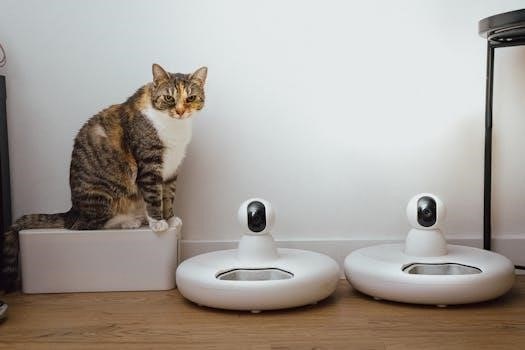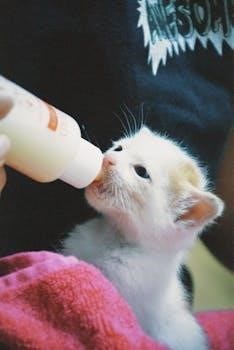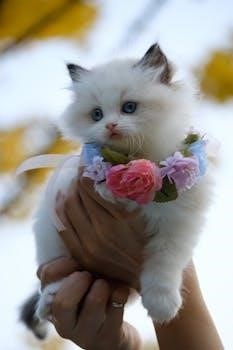
feed the cats program pdf
Feline feeding programs should mimic natural behavior, reducing begging, frustration, and conflict. This also enhances the bond between cats and their owners. Optimal programs include play and predation to meet nutritional needs and reduce stress.
The Importance of Mimicking Natural Feeding Behavior
Mimicking a cat’s natural feeding behavior is crucial for their well-being, as it minimizes issues like begging, frustration, and conflict, especially in multi-cat households. Simulating how cats would naturally eat, which includes hunting and small, frequent meals, reduces stress and enhances the bond between cats and their owners. This approach also helps prevent relinquishment. By considering a cat’s innate instincts, feeding programs can more effectively meet both their behavioral and nutritional needs. It is important to remember that cats are natural hunters, and their feeding patterns should be in line with this. This method will help ensure a happier and healthier life for the cats. Such a strategy of feeding aligns with their intrinsic needs and contributes to their overall well-being.

Key Principles of Cat Feeding
Feeding strategies must be tailored to each cat and household, prioritizing individual needs. These programs should meet nutritional requirements for overall health. It is very important to follow these key principles.
Tailoring Feeding Strategies to Individual Cats
Individual cat needs vary, and feeding programs should be customized accordingly. Consider the cat’s age, activity level, and any health conditions. Some cats prefer grazing, while others do better with scheduled meals. Owners should offer multiple feeding options, such as food puzzles or varied meal types. It’s essential to monitor each cat’s food intake and adjust the program as needed to ensure their specific dietary needs are met. A program that works for one cat may not work for another in the same household. This tailored approach promotes both physical and mental well-being in cats.
Meeting Nutritional Requirements
Cats are obligate carnivores, requiring a diet high in protein. Meeting these nutritional requirements is crucial for their health. A balanced diet should include essential amino acids, vitamins, and minerals. Commercially prepared, feline-specific foods are usually formulated to meet these needs. Owners should be aware of the specific dietary needs of their cats, which can change with age and health status. It is important to select high-quality food with a good protein source. Consulting a veterinarian can help determine the best diet for each cat’s unique needs, ensuring they receive the necessary nutrients.
Understanding Cat Feeding Behavior
Cats naturally prefer small, frequent meals. An empty stomach triggers a hunger response after 8-10 hours; Regular, routine feeding times help regulate their bodies and reduce begging for food.
Frequency of Meals and Hunger Response
A cat’s feeding behavior is closely linked to its natural instincts. After approximately 8 to 10 hours, an empty stomach begins to signal the brain, initiating a hunger response. Therefore, providing at least two meals per day is generally recommended to satisfy a cat’s physiological needs. Imagine having only one meal daily; this highlights the importance of regular feeding schedules. Routine feeding times help a cat’s body regulate its processes and can significantly reduce instances of begging for food. Cats generally prefer to eat several small meals throughout the day, reflecting their natural hunting patterns. Understanding these natural patterns can help create a feeding program that is best suited for your cat and its behavioral needs.
Practical Feeding Recommendations
Transition to new food gradually, starting with a 25/75 ratio of new to current food. Daily caloric intake depends on weight and body type; use product guidelines as a starting point.
Transitioning to New Food
When introducing a new food to your cat’s diet, a gradual approach is essential to avoid digestive upset and ensure a smooth transition. Begin by mixing a small portion of the new food with your cat’s current food. Start with a ratio of approximately 25% new food and 75% current food. Over the next three days, slowly increase the amount of new food while decreasing the amount of the current food. This gradual process allows your cat’s digestive system to adapt to the changes in ingredients and textures. Avoid sudden switches to prevent potential issues such as vomiting or diarrhea. The goal is to seamlessly incorporate the new food into your cat’s diet without causing any discomfort or stress. Consistency and patience are key to a successful transition.
Determining Daily Caloric Intake
Determining your cat’s daily caloric intake is crucial for maintaining a healthy weight and overall well-being. The specific amount depends on various factors, including your cat’s weight, age, activity level, and body condition. As a general guideline, a lean 5-pound cat typically needs about 170 calories per day, while a lean 10-pound cat needs around 280 calories per day. Always consult the feeding guidelines provided on the packaging of your cat’s food as a starting point. However, these are simply recommendations and may need to be adjusted based on your cat’s individual needs. Monitoring your cat’s weight and body condition regularly is essential to fine-tune their caloric intake. If your cat is gaining or losing weight, adjust their portions accordingly. It is also best practice to seek advice from a veterinarian for individualized recommendations.
Customizing Feeding Programs
Customized programs should incorporate play and predation, meeting each cat’s needs for a safe eating location. Feeding programs must be tailored to individual households and cats’ specific requirements for overall well-being.
Integrating Play and Predation
Incorporating play and predation into feline feeding programs is crucial for addressing their behavioral needs. These activities help satisfy their natural instincts, reducing stress and boredom. By simulating hunting through interactive toys and puzzle feeders, cats can engage in physical and mental stimulation. This approach not only provides an outlet for their energy but also enriches their environment. Encouraging predatory behaviors through play is essential for their overall well-being, as it promotes a more natural and fulfilling lifestyle. Play also helps to reduce problematic behaviors associated with hunger or boredom. These practices are important for well-being.

Special Considerations for Different Cats
Kittens require more food per pound than adult cats, often needing three meals daily. Senior cats may need adjustments based on health or reduced activity levels and require special care.
Kittens and Senior Cats
Kittens have unique dietary needs due to their rapid growth, requiring more food per pound than adult cats, often needing three meals a day until around six months of age, transitioning to twice daily feeding as they approach one year. Senior cats might require adjustments based on potential health issues, reduced activity levels, or changes in their ability to absorb nutrients. It’s vital to monitor their weight and body condition closely, adjusting portion sizes and food types as needed to ensure they maintain a healthy weight and receive adequate nutrition. This may include softer food or food designed for older cats. Consulting with a veterinarian is crucial for tailoring a specific plan.

Community Cat Feeding Guidelines
Feeding areas should be on your property or with permission. Create a routine, feeding in the same place. Discrete dining is important, ensuring a safe and consistent feeding environment for community cats.
Discrete Dining and Routine
When feeding community cats, it’s crucial to establish a discrete dining area, preferably on your property or a location where you have explicit permission to feed. This ensures the cats’ safety and minimizes potential conflicts with neighbors or other animals. A consistent routine is also vital; feeding cats at the same time and in the same place helps them feel secure and reduces stress. This predictability allows them to anticipate meal times, creating a sense of stability. This approach benefits not only the cats but also the local community by ensuring a controlled and responsible feeding practice. Additionally, a routine helps you monitor the cats’ health and well-being more effectively.

Additional Factors in Cat Feeding
Treats should be limited to 10-15% of daily calories, and certain foods must be avoided. Track your cat’s food intake and seek veterinary advice for a balanced diet.
Treats and Food to Avoid
While treats can be a part of a cat’s diet, they should not exceed 10 to 15 percent of their daily caloric intake. Overindulgence in treats can lead to weight gain and nutritional imbalances. Some foods are particularly harmful to cats and should be avoided completely. These include chocolate, onions, garlic, grapes, raisins, and products containing xylitol, an artificial sweetener. These items can cause serious health issues, including vomiting, diarrhea, lethargy, and even organ damage. Always research a food before offering it to your cat to ensure its safety, and when in doubt, consult a veterinarian. A balanced diet is crucial for your cat’s well-being.
Tracking Food Intake and Veterinary Advice
Monitoring your cat’s food intake is essential for maintaining their health and well-being. Owners should track the overall daily amount of food consumed, using a scale to weigh portions accurately. This allows for precise adjustments to their diet as needed. Consulting with a veterinarian is crucial for personalized feeding recommendations. Veterinarians can assess your cat’s individual needs, considering factors like age, weight, activity level, and any underlying health conditions. They can also help you identify the best type of food and portion sizes for your cat. Regular veterinary check-ups and advice are vital to ensure your cat receives optimal nutrition and stays healthy.
Related Posts

lotf pdf
Get the Lord of the Flies PDF for free! Download the full eBook, study guide, and analysis to enhance your reading experience.

house tree person interpretation free pdf
Discover the deep symbolism behind house, tree, and person interpretations. Get your free PDF guide now and uncover the secrets!
gingerbread house coloring pages pdf
Download free gingerbread house coloring pages in PDF! Perfect for kids and adults, these festive designs bring holiday cheer. Print and color now!